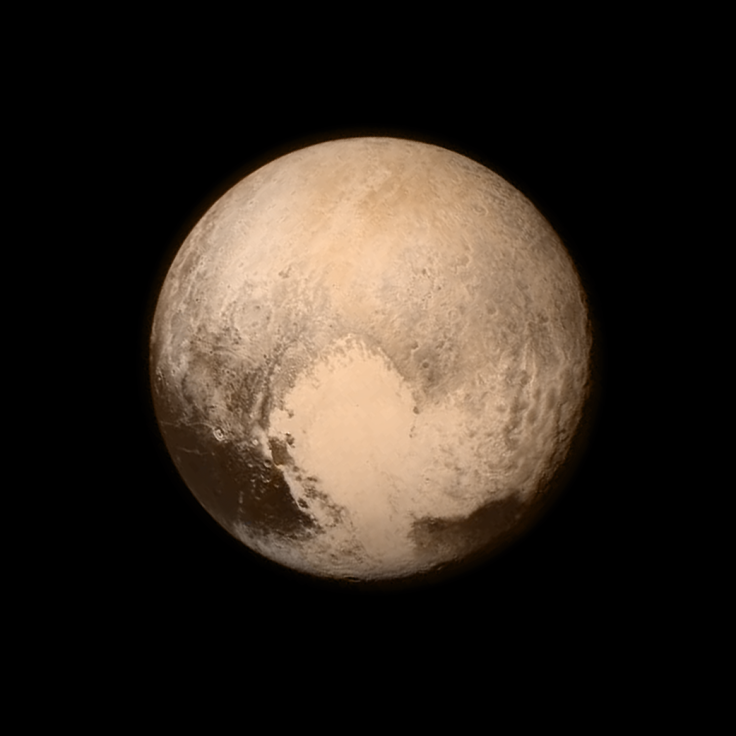NASA New Horizons Pluto Flyby Is A Time Of Joy And Waiting

Orkan Umurhan, a geology and geophysics post-doc at NASA Ames Center, was speechless at 7:49 a.m. EDT today. At that moment, New Horizons was just 7,800 miles from Pluto. Umurhan is part of the team at Johns Hopkins Applied Physics Laboratory (APL) working on the mission and let out a whoop of excitement at a moment that was nine years in the making.
Umurhan, the team at APL, Neil deGrasse Tyson at the American Museum of Natural History and institutions across the world were able to share in the excitement of the historic flyby. New visualization technology let everyone experience the moment New Horizons began taking photos from 7,800 miles away. At the American Museum of Natural History, Tyson along with Carter Emmart, Director of Astrovisualization, and Curator Denton Ebel watched the simulation of New Horizons at Pluto and its moon Charon, and it was like we were at Pluto with hundreds of people tuning into the event.
We all know Pluto's sad saga by now. It's just a dwarf planet, but it's still an important member of the solar system and exploring it will provide a new understanding of our universe. Tyson is firmly in the "Pluto is a dwarf planet" camp and has some interesting exchanges with Alan Stern, principal investigator of the New Horizons mission. Stern believes Pluto should be considered a planet, but both agree about its significance.
Tyson said the observation is more than just the completion of the initial reconnaissance of our solar system, because there is the entire Kuiper Belt that has yet to be explored. He called it the "first exploration of a new swath of real estate."
Just an FYI: Pluto and I buried the hatchet a long time ago. And we’ve been pals ever since. pic.twitter.com/zPQNymxVUV
— Neil deGrasse Tyson (@neiltyson) July 8, 2015Fresh data from New Horizons observations have already determined Pluto's actual size and it's larger than expected. At a diameter of 1,473 miles, Pluto is "the king of the Kuiper Belt" and is larger than Eris. The images of Pluto and Charon have also revealed interesting surface features and a chasm on the latter that appears to be larger than the Grand Canyon on Earth.
Researchers hope to learn more about the interaction between Pluto and Charon. The two objects are tidally locked -- only one side is ever facing the other -- and Charon is about half the size of Pluto. The observations from New Horizon could confirm if Pluto and Charon are a "double dwarf planet." Pluto's atmosphere in the Kuiper Belt is quite large, and it's possible that Charon shares a piece of that atmosphere.
Further observations could uncover new moons and even a ring system, if it exists.
"This mission has inspired people across the world with the excitement of exploration and what humankind can achieve," Stern said in a statement. New Horizons sped by Pluto at a speed of 30,000 miles per hour, but it will deliver 10 years' worth of data over the next 16 months.
Pluto is the gateway to the Kuiper Belt -- a disc of icy objects beyond Neptune -- which is home to dwarf planets and trillions of comets. The Kuiper Belt is home to four of the known dwarf planets in our solar system -- Pluto, Eris, Makemake and Haumea -- and could be home to a hundred more dwarf planets.
"We have expanded our understanding of the universe," David Grinspoon, astrobiologist and senior scientist at the Planetary Science Institute, said during the Pluto flyby.
While NASA and the New Horizons teams celebrate the accomplishment, they are still holding their breath Tuesday. New Horizons is busy collecting data and will not be in communication with Earth until 9 p.m. EDT. What's a few more hours after nine years?
© Copyright IBTimes 2024. All rights reserved.











